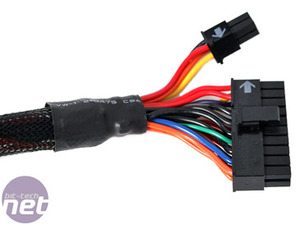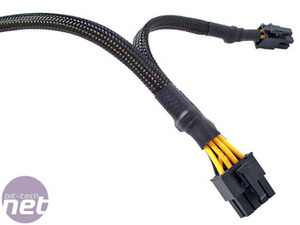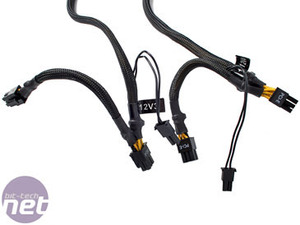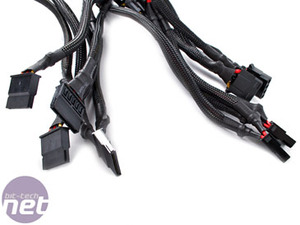
800W of Shiny, Shiny, Shininess
Be careful and don't open it in the sun because you might blind yourself. The finish isn't a perfect mirror but it's quite close. Naturally this kind of finish doesn't bode well for fingerprints, but thankfully they come off easily although if you've any level of OCD you'll want to keep a cloth handy to wipe it down with.The unit is dominated by both the large black 13.5 cm fan in the top, and the BFG branding in the centre and embossed into the sides. It's a far subtler design than Corsair employs - no large badge here. There's no bling lights either, it feels very serious in the way it was designed.
The back gets the usual honeycomb grill, but the other sides also feature slits to let the hot air out too.
BFG employs a four rail design, with a weighting towards rails three and four that provide power to the PCI-Express cables exclusively. Rail one is for the EPS 12V cable only and rail two is split between the ATX connector and peripherals. While we're slightly in preference to good single rail designs because they provide the maximum power all of the time, we have to say this setup is very good as as it splits all the major components precisely into four.
Cables Provided
- One 50cm 20+4-pin ATX cable
- One EPS 12V cable with 8-pin connector at 50cm and 4-pin at 65cm
- Two PCI-Express cables with a 6+2-pin connector at 50cm and 6-pin connector at 65cm
- Two Molex cables with three connectors at 50cm, 65cm and 80cm and a floppy connector at 95cm
- Two SATA cables with three connectors at 50cm, 65cm and 80cm.
There are a few things that we don't necessarily agree with though - for an 800W unit, why do you need a 20+4pin ATX connector? For choice, sure that's always a bonus, however anyone with a PC based around a motherboard that uses a 20-pin ATX connector does not need this much power, that's for sure.
Likewise, the EPS and PCI-Express cables look messy with extra connectors dangling off the ends. That's before we saw the extra 2-pin adapters for them (to make the PCI-Express 8-pin), which quite frankly look extremely ugly. The cable is thicker than usual which is beneficial because it'll have a lower resistance, but they are unnecessarily long and add to the cluttered feel.
We do get the fact that the dangling connectors mean that you don't have to wire down a whole new cable, so SLI or high end graphics cards can be supplied by a single cable - that's a good idea in principle, but without being detachable it's messy and additionally stresses the three yellow 12V wires running down the single cable.
The 12V EPS connector is an even worse decision - you'll only ever need an 8-pin or 4-pin on a normal consumer motherboard, so you'll always be left with one dangling about. However if you did want to use the ES-800 for a server or workstation board which requires both connectors, you can't simply because there's not enough cable between them to reach.
If all your plugs and sockets are 50cm away from the PSU, then it'll fit your system perfectly. Normally though, hardware are not all placed in an equidistant circular circumference away from the power supply - a little variation might be nice instead of being left with either too much or too little cable. In our opinion 800W could support more than six SATA, especially since optical drives are moving this way too. Finally, while all the connectors are nicely colour coded to match the cables and heatshrinking, the Molex connectors don't have easy push-release clips on them either.
Overall, it feels like BFG went to great lengths with the aesthetics but forgot about actually using it before it went to ship. What it makes us think of is a tick-box list of "six SATA, six Molex, 8-pin and 4-pin EPS 12V, four PCI-Express with 8-pin support.. yep, yep, yep, yep." In some ways this is the difference between buying from a power supply company and someone who makes power supplies.

MSI MPG Velox 100R Chassis Review
October 14 2021 | 15:04
















Want to comment? Please log in.